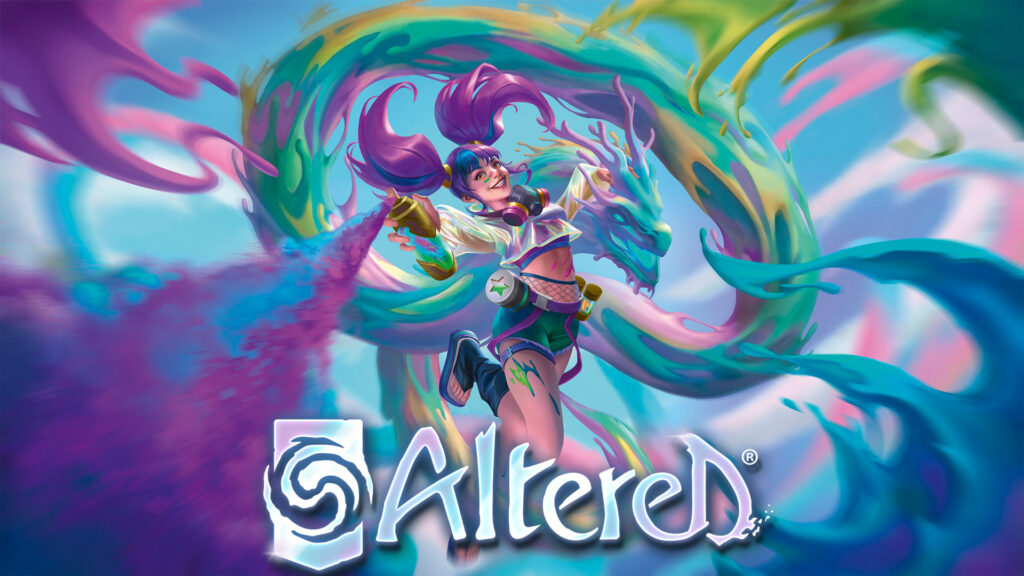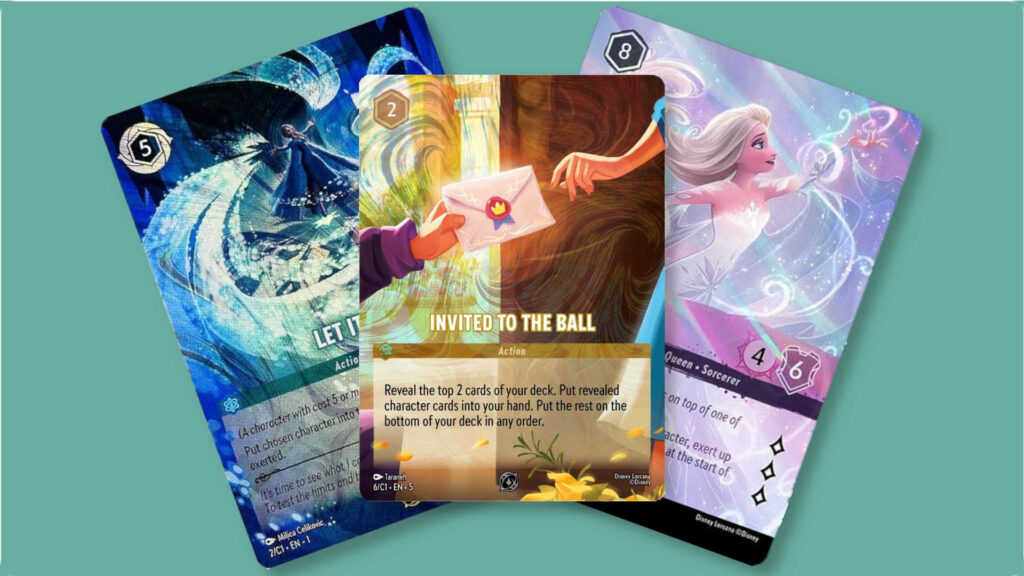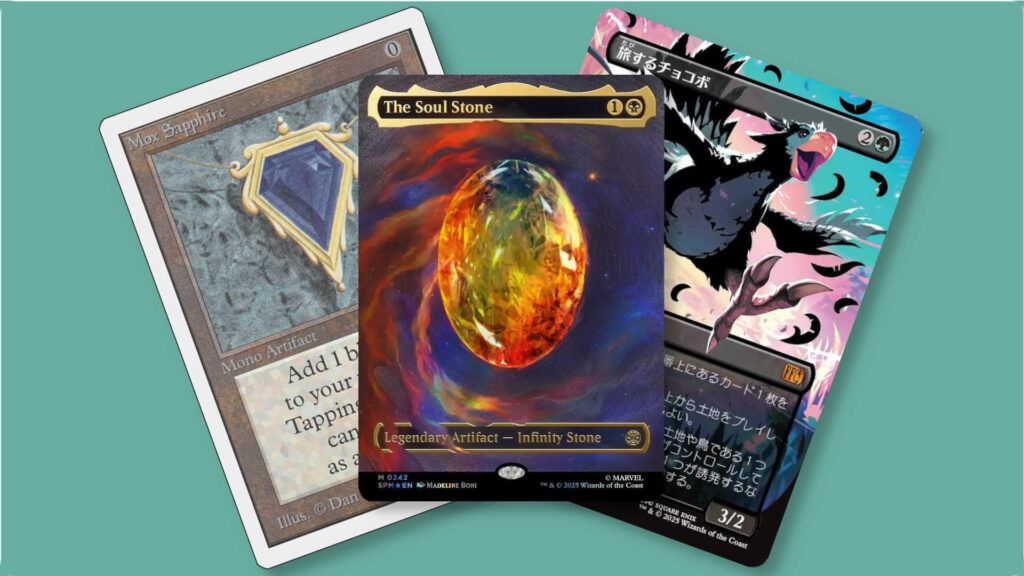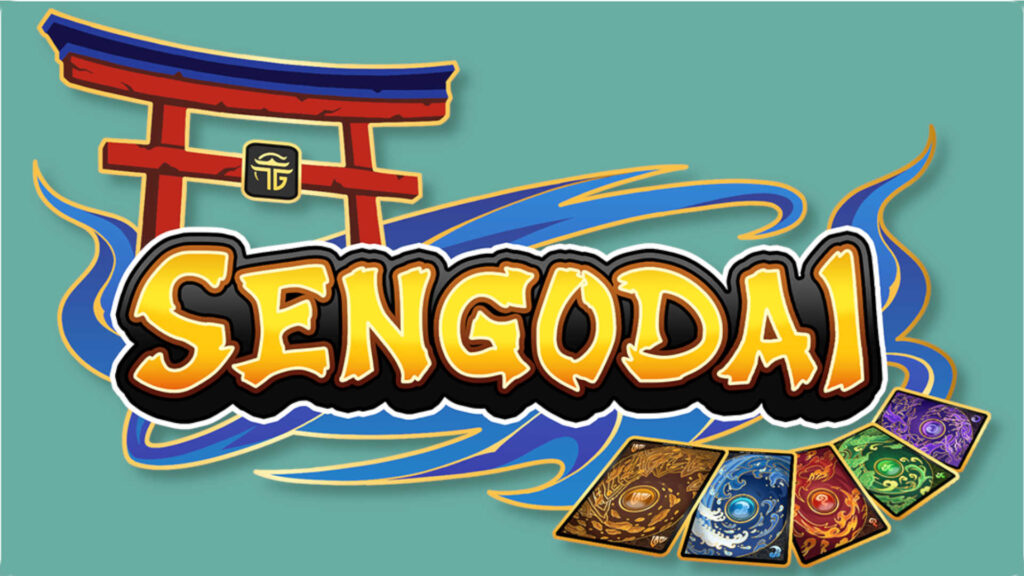Images courtesy of Equinox
Hello everyone, and welcome back to the final instalment of my series on reviewing and upgrading the starter decks for each faction in Altered. I’ve saved this faction for the last article since I’ve been agonizing over how to actually recommend upgrades for it.
So let’s not delay the inevitable and jump right into the starter decklist!
Table of Contents
ToggleLyra Starter Deck List

Here’s the complete decklist for the Lyra Starter Deck:
Hero
1x Nevenka & Blotch
Characters
2x Ouroboros Trickster (c)
1x Ouroboros Trickster (r)
2x Esmeralda (c)
1x Esmeralda (r)
3x Lyra Skald (c)
3x Hathor (c)
3x Lyra Cloth Dancer (c)
3x Lyra Chronicler (c)
2x Tanuki (c)
1x Tanuki (r)
3x Ouroboros Croupier (c)
3x The Hatter (c)
2x Asmodeus (c)
1x Asmodeus (r)
1x Kadigiran Mage-Dancer (r, f)
Spells
3 x All In! (c)
2 x Paint Prison (c)
1 x Paint Prison (r)
1 x Off You Go! (r, f)
Permanents
1 x The Ouroboros, Lyra Bastion (r)
Lyra Starter Deck Review

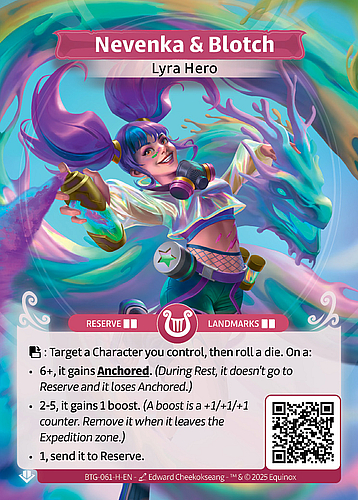
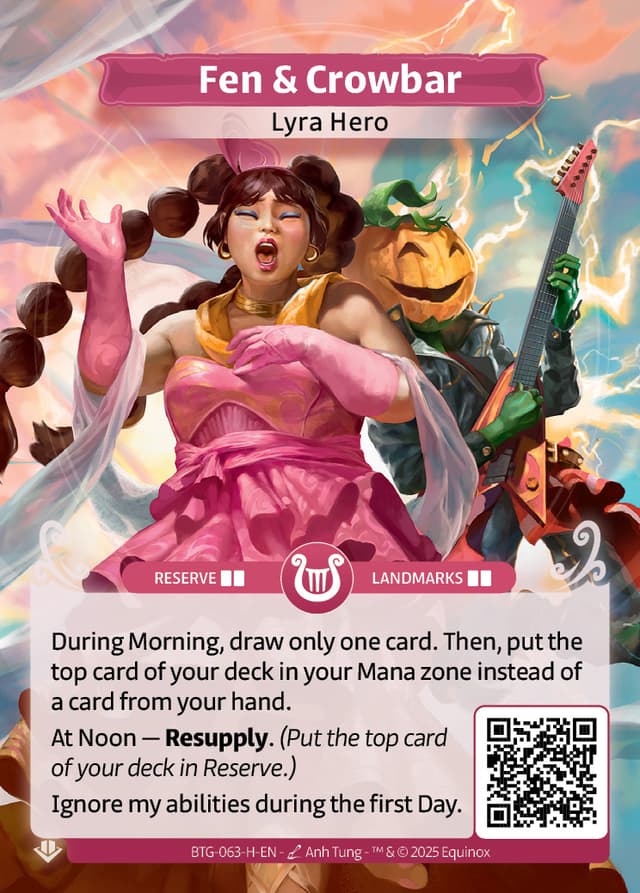
The main issue I have with this starter is in the hero they chose and the faction identity as a whole. The Lyra faction is based on randomness; two of the three heroes, Nevenka & Blotch and Auraq & Kibble, both have an element of inherent variability built into them. The problem is that the third hero, Fen & Crowbar, fundamentally changes the way you take your turn, so it would be a poor introductory hero to the game. So you’re left with one of the two that create additional randomness, leaving the starter deck to be one that literally relies on the roll of a die.
Nevenka & Blotch lets you roll a die as a side action to give a friendly character either a boost on a roll of a two, three, four, or five, Anchored on a six, and sending it to reserve on a one. The primary issue is that in the wording of her ability, she requires you to pick the character before resolving it, so you’re extremely committed on activation.
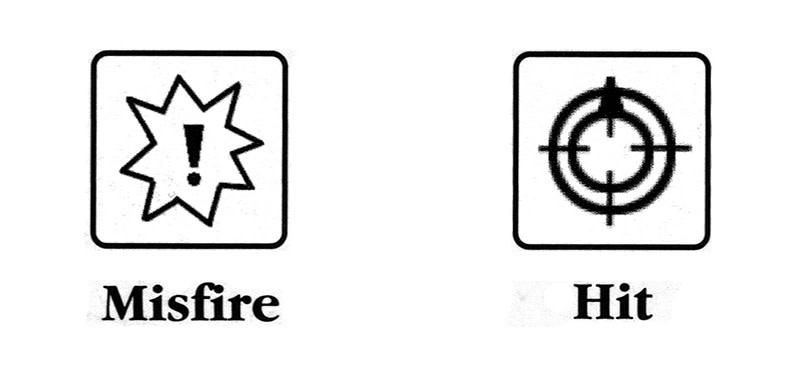
I’m going to dip into another game for a comparison in this risk-reward scenario, so please bear with me real quick. In Warhammer Fantasy Battle, the original, fantasy equivalent of Warhammer: 40,000, cannons can do a ton of damage. The problem is that on the roll of their die, there’s a one in six chance to misfire and potentially instantly destroy your own cannon in the process.
However, the damage output of the other five faces of the die is usually worth the risk of the one-sixth chance to immediately blow yourself up. Compare that to Nevenka’s ability, and the high of Anchored is an amazing upside, and the downside is backbreaking, but the most common result giving a single boost is not worth it to even activate her in some occasions.
When the best play is just to pass back, something’s gone wrong.
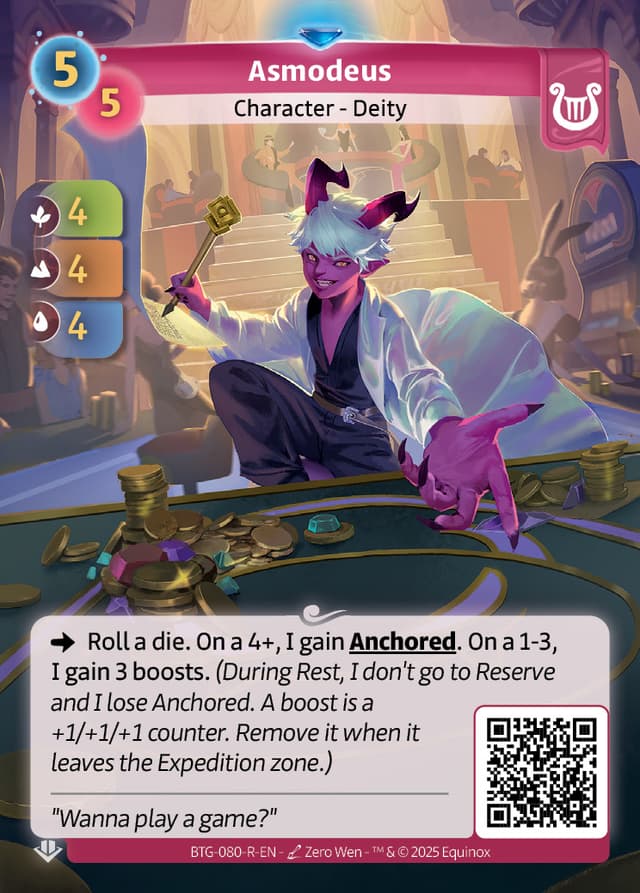
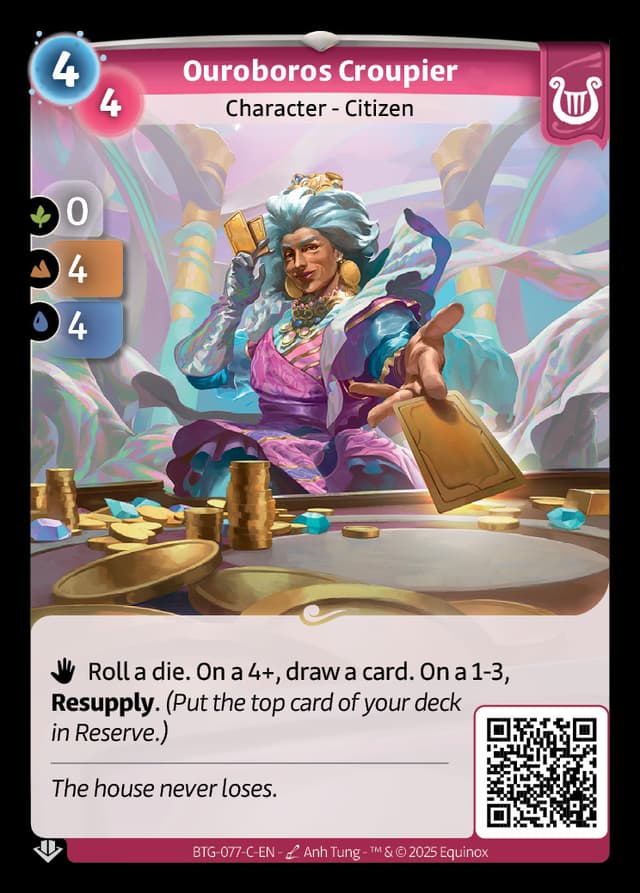
The character selection does its best to actually give you a playable spread of early threats and interaction, backed up by some of the more on-theme dice rolling top end in the form of Asmodeus. However the deck provides next to no ways to modulate or control your dice rolls, which leads into my next issue with this starter: the lack of control.
The biggest issue I have with the deck is that it fundamentally doesn’t allow for any control on your results. There’ll be different contexts in which you want a specific result, even if that may not be the higher result on the list of possible results. This means that an expensive character like Asmodeus sometimes just does nothing because it Anchored itself in the face of a wall of stats from the opponent, or gave itself three boosts when it was already winning handily.
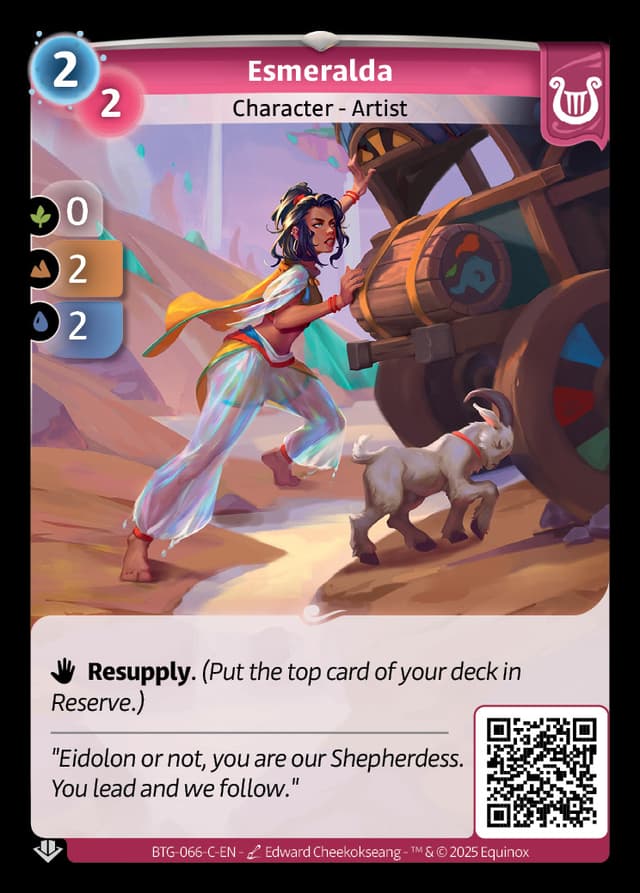
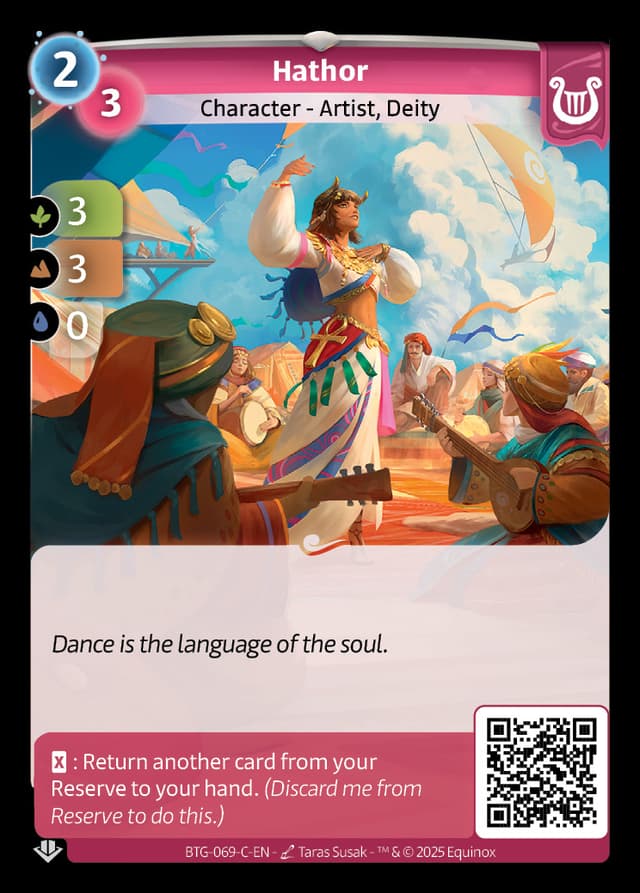
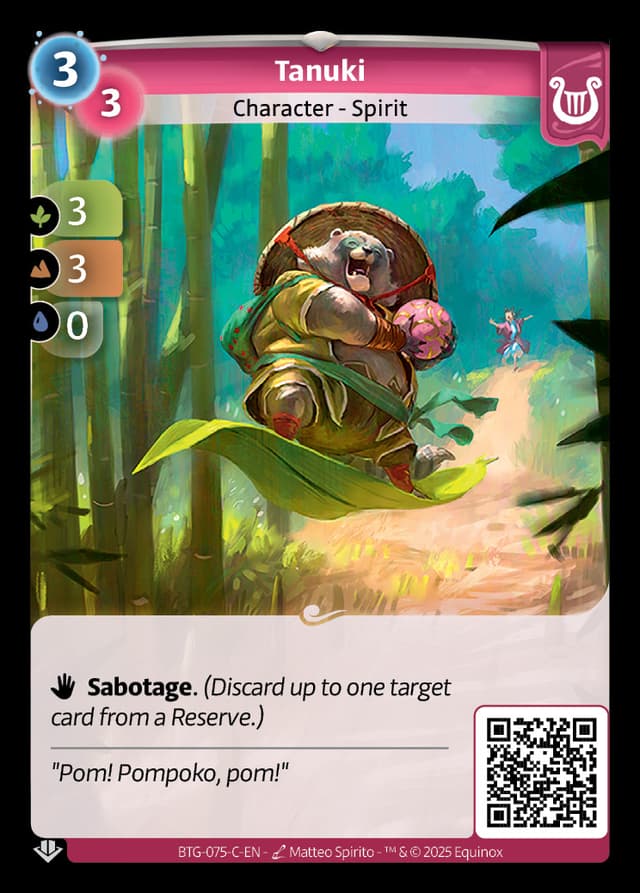
I understand that this is part of the experience when it comes to what Equinox probably had in mind when designing this starter, but as a starter deck, it just leaves players with a bad taste in their mouth when so much of the deck revolves around such a high degree of variability and chance. The cheap characters, like Hathor, Lyra Skald, Esmeralda, Tanuki, and even the early game dice-roller Ouroboros Trickster, at least let you just play the game normally without going all in on dice rolling, but leads to a decklist that is less synergistic with the hero and does little in reinforcing any sort of a cohesive faction identity.
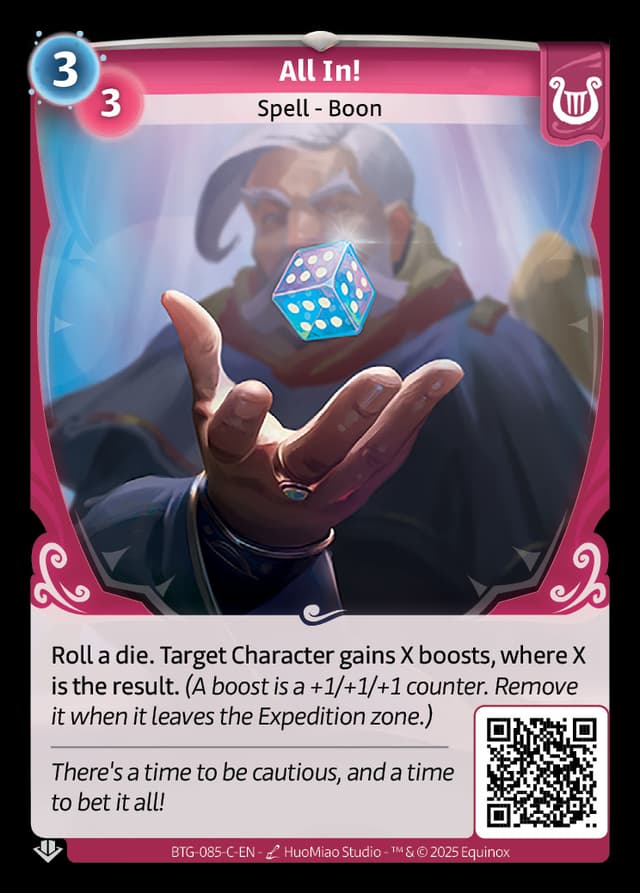
This is the starter deck I’d be the least eager to recommend to someone new to Altered, as it can easily create the most feel-bad moments. The card that really exemplifies this the most is the spell All In! which, as the name suggests, is extremely all in commitment onto a single character, leaving you vulnerable to a single removal spell more so than any other faction.
The rare copy of The Ouroboros, Lyra Bastion, is actually a step in the right direction if you were to focus on dice rolling as a core theme due to how it adds extra control to your rolls, but only including one copy just makes the variability of the starter deck feel even more extreme.
Lyra Starter Deck Upgrades
With that in mind, the upgrades I’m suggesting for this starter will try to solely focus on the dice rolling aspect, and maximizing its potential.
I genuinely thought about changing out the hero to Fen & Crowbar for this upgrade guide, but it would’ve required an entire overhaul of the deck and a lot of further explanation on the deck’s play style, so it would’ve been disingenuous to call it an “upgrade” at that point. That being said, I’ll have to break the 10 rare rule I’ve imposed on myself throughout this series, since there is so much Nevenka needs in order to be playable to a high enough standard.
The main goal of the deck is to generate advantage in a traditional Lyra midrange shell utilizing many of the existing grindy engine cards, with a package of dice rolling to power up Kadigiran Mage-Dancers and to allow additional stats or anchoring from Nevenka’s ability.
Dice Rolling!
3x Martengale (r)
2x The Ouroboros, Lyra Bastion (r)
3x Kadigiran Mage-Dance (r, f)
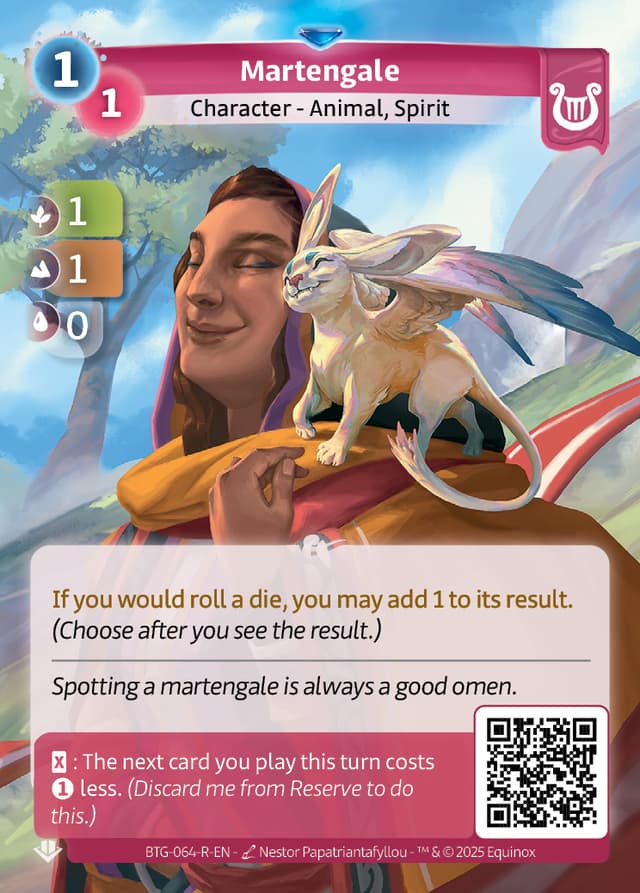
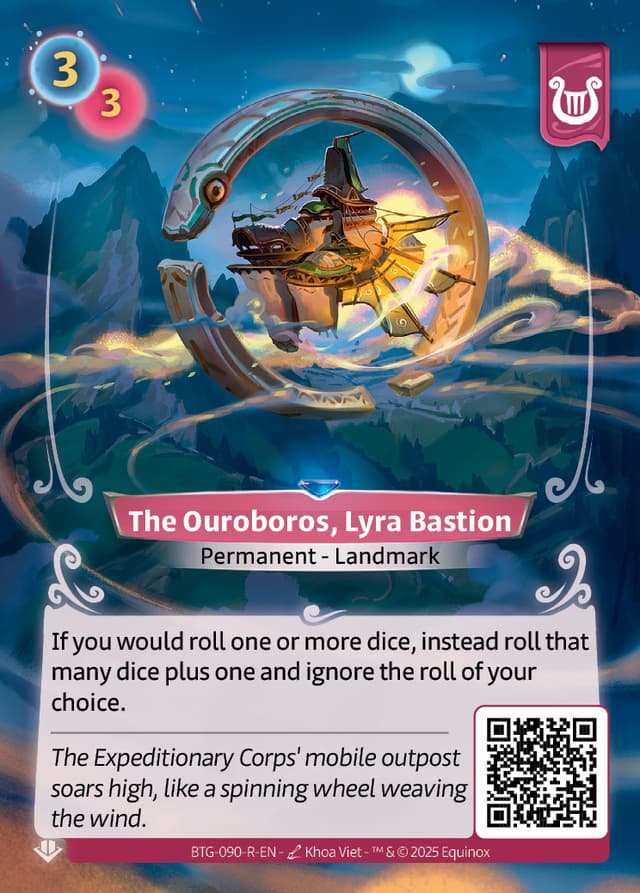
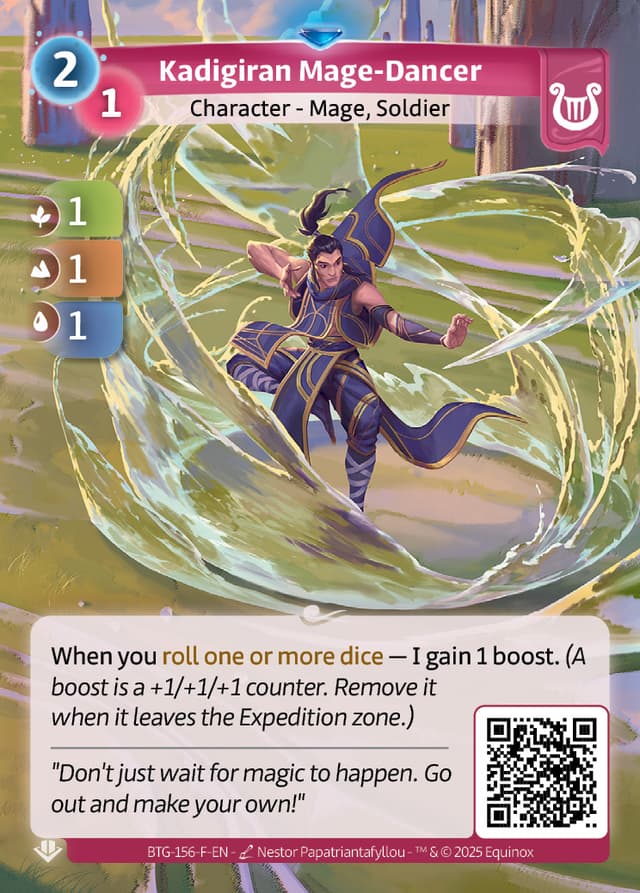
First things first, we need to add in ways to either control or modify dice rolls. To achieve that, the rare copy of Martengale, which allows you to add one to your dice rolls, and a full set of rare Ouroboroses is mandatory. Without either of these cards, you’re basically exposing yourself to the whims of the dice. Kadigiran Mage-Dancer doesn’t help you roll dice better, but it pays off for each instance of rolling instead. Having a scaling threat at least pays for jumping through all these dice rolling hoops.
The other thing to note is that with either Martingale or Ouroboros in play, Nevenka’s ability becomes much easier in landing the six, which means that consecutive turns of anchoring a big Mage-Dancer can become a win condition by itself.
Even More Dice Rolling!
3x Ouroboros Trickster (c)
3x Snowball Commando (c)
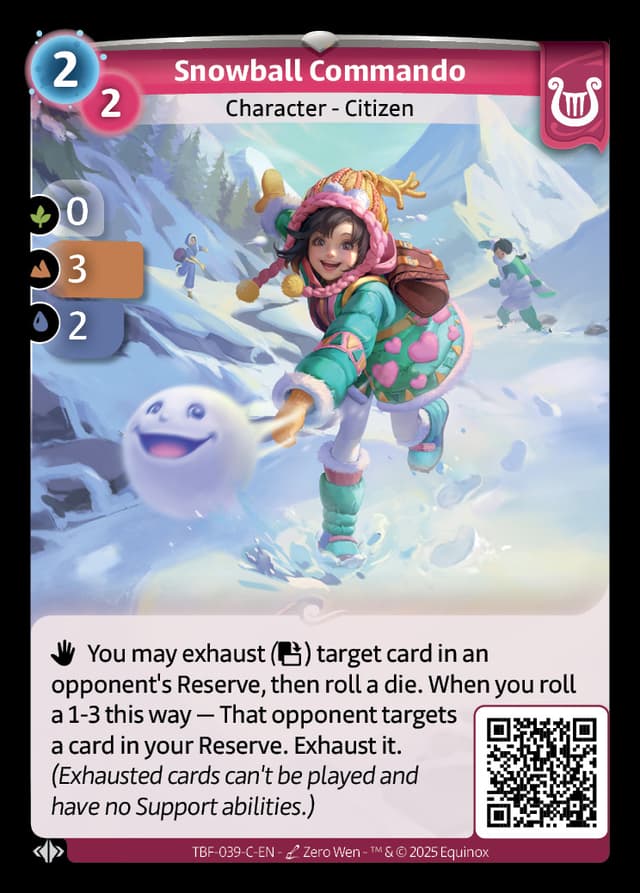
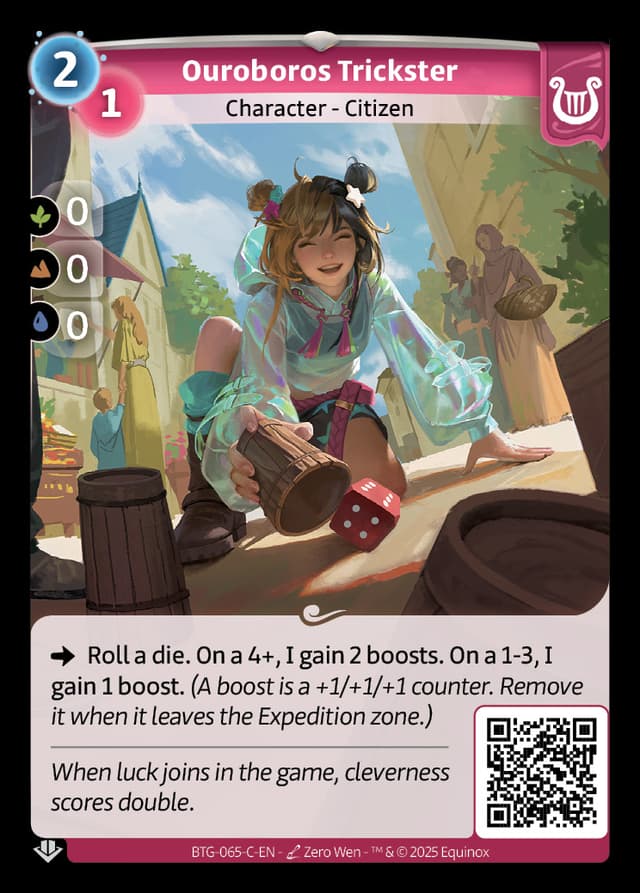
The second thing we need is cards that roll dice, but do so without disastrous consequences – mainly cards that roll dice as a way to gain boosts for a shot to be above rate so that we can get the Mage-Dancers into reliable threats that can solo contest an expedition.
This might sound wild, but we only want cards that are reasonable on the stats to hand-cost ratio, which leaves us only with two viable options: Ouroboros Trickster, and Snowball Commando. The Trickster is less efficient on stats, having a 50% chance of being a 1/1/1 for two from hand, but rolling the dice when entering from both hand and reserve means more value for the Mage-Dancer.
On the other hand, Snowball Commando has stats that are respectable at 0/3/2 for a two hand-cost, but the best part about it is that its disruption always goes off no matter the result of the roll. The worst outcome on the roll’s failure just ends with both players having an Exhausted card in reserve, which is something you can actively control by not having anything in reserve! Having an attribute in three for a two-cost card is extremely beneficial in early contests, and the Exhaust cards tending to have higher stats relative to their Sabotage counterparts makes it a fine character to play out at any point in the game.
Card Advantage
3x Ouroboros Inkcaster (r)
2x Magical Training (r, f)

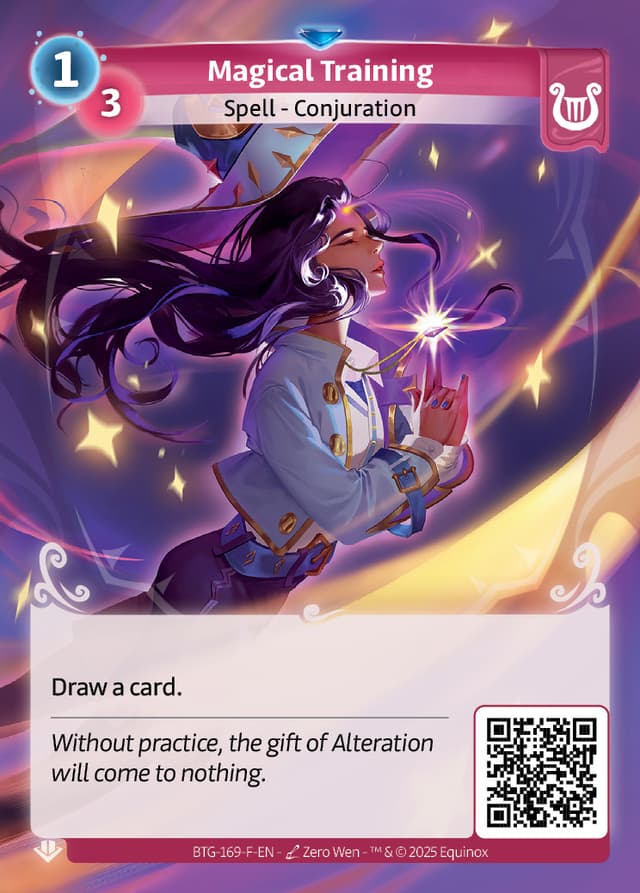
Taking a page out of Fen & Crowbar’s book, Lyra is actually quite well equipped to generate a grindier value engine using a few cards. While Fen abuses this fact more aggressively by being solely built around it as well as utilizing as many cost-reducing reserve abilities as possible, here we’re only looking to buy back spells that have a low hand-cost.
The main card that allows us to loop anything are the rare copies of Ouroboros Inkcaster, which is, dare I say, the best Lyra character. Two copies of the Inkcaster can loop each other continuously just by themselves, allowing you to get additional value out of spells that you’d never want to play from reserve, like Magical Training or Off You Go!, and they stop any type of overflowing reserve that can come from playing a bunch of spells in the same turn.
Interaction
2x Off You Go! (r, f)
2x Cloth Cocoon (c)
3x Tanuki (c)
2x Twinkle Twinkle (c)
2x A Cappella Training (c)
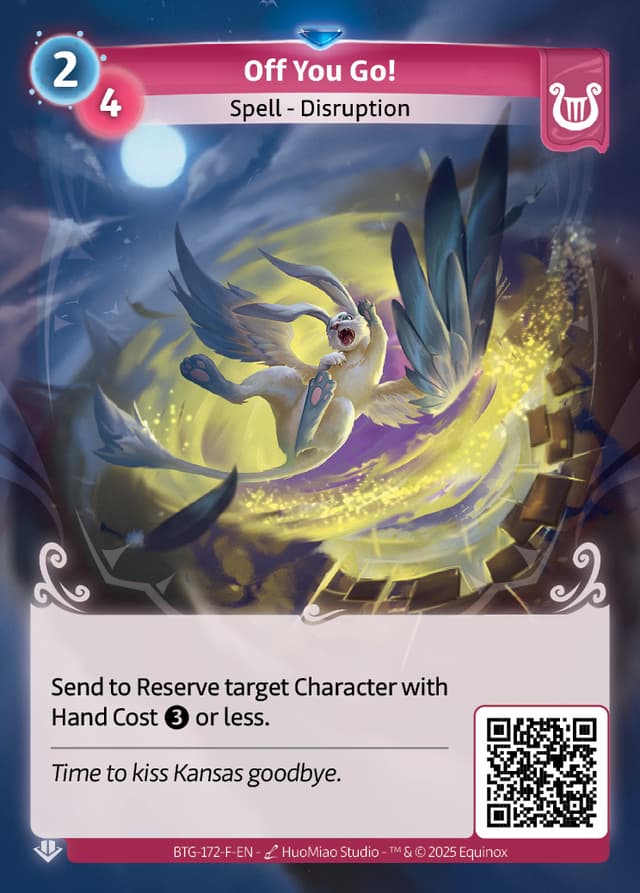

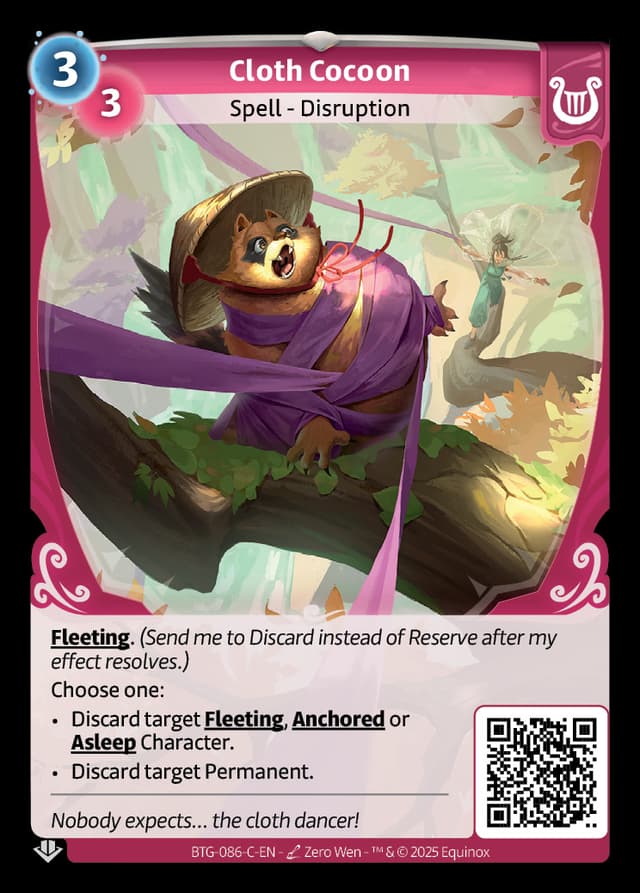
This is a lot of removal, but it’s a necessary cost when our game plan involves nickel-and-diming our opponent out with value while trying to win with a few characters. Tanuki is well statted for a saboteur, and the removal suite hits a wide range of threats, with the common Cloth Cocoon being one of the few that can remove characters regardless of hand cost.
Best of the Rest
3x Hathor (c)
2x The Sandman (c)
2x The Snowman (c)
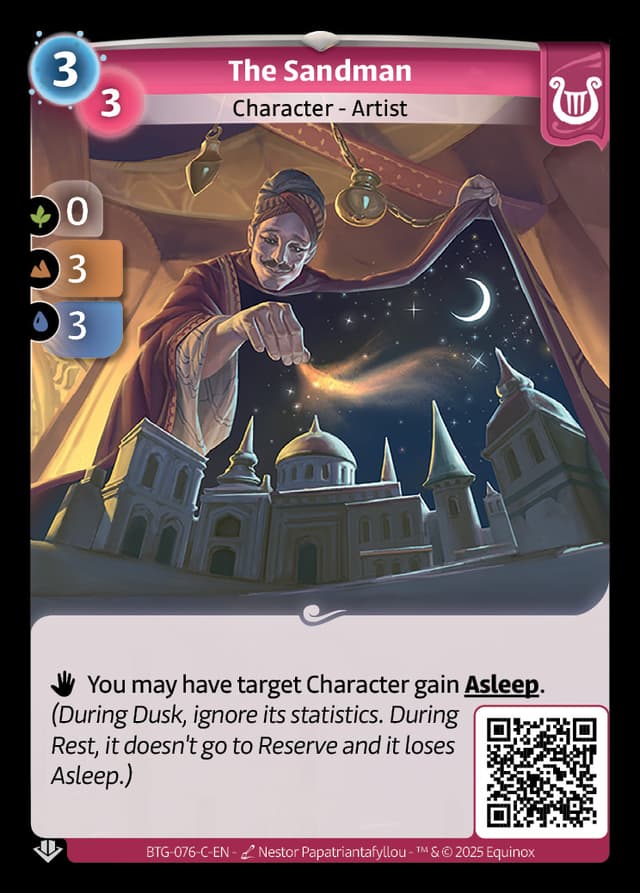
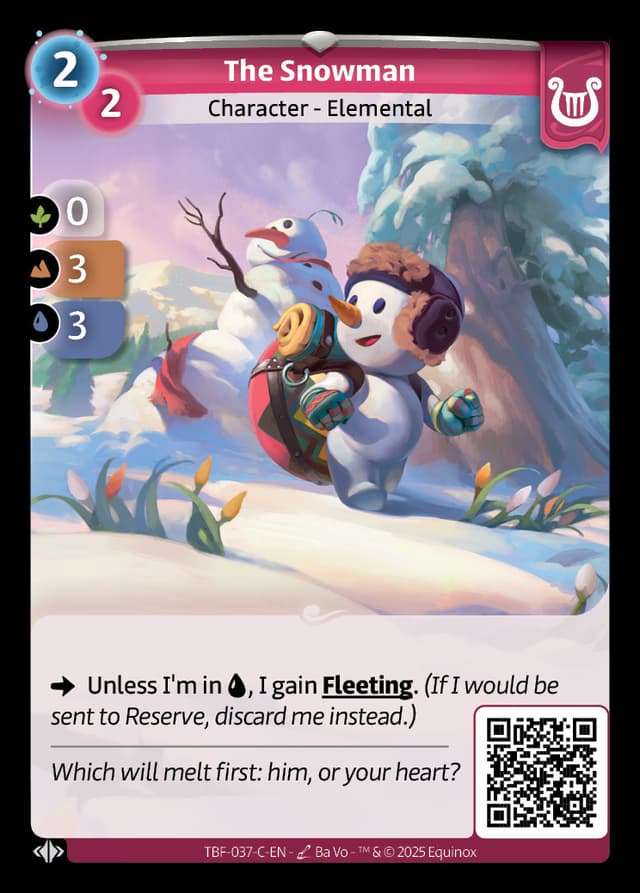
I’ve opted to fill the rest of the deck out with solid, efficient two-drops that can contest early, and the highly versatile Sandman who can act as either a pseudo-Anchor or removal spell depending on the situation. The main thing shared by all these cards is the three stat in multiple attributes that makes them all solid contesters at most stages of the tumult. Hathor is one of the more vital glue cards when it comes to Lyra as a faction, since it’s one of the few ways to rebuy any card out of the reserve at common that doesn’t cost any mana or take an action to do so.
Ultimately, this deck is a work in progress, since so much of the essentials are tied up in the rares that care about rolling dice in order to distinguish it from just a worse version of a Fen midrange deck. I’d highly recommend seeking out the few cards that care about dice rolling first before the value package, since the core conceit of the deck revolving around dice rolling only works as well as your ability to manipulate, control, and take advantage of each roll.
Final Thoughts on the Lyra Starter Deck
I think Lyra is an incredibly challenging faction to build for, especially if the hero isn’t Fen & Crowbar. Ultimately, you’re going to have to borrow some of the cards that make Fen a midrange value monster to incorporate into the more chance-based strategies, and that’s what I’ve done in the upgrades.
I really had a lot of fun upgrading and reviewing each of the six starter decks for Altered. Next time we’ll go over all the exciting news that’s been happening in the game, as well as start planning out some more specific deck analysis.
Check out the rest of our starter deck guides here: Axiom, Yzmir, Ordis, Muna, Bravos.

